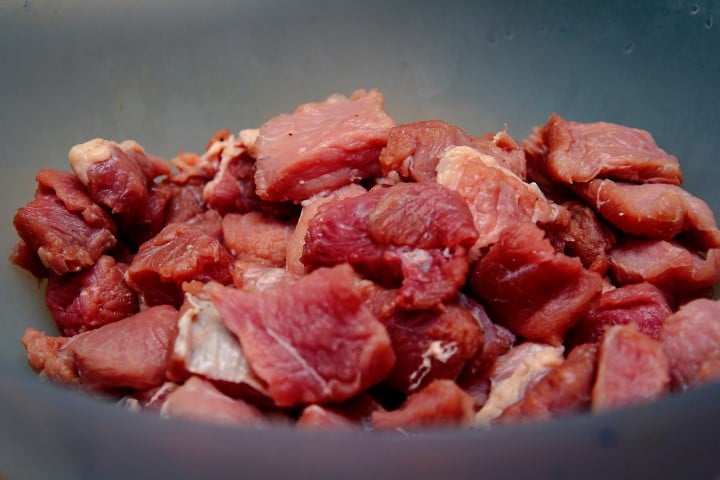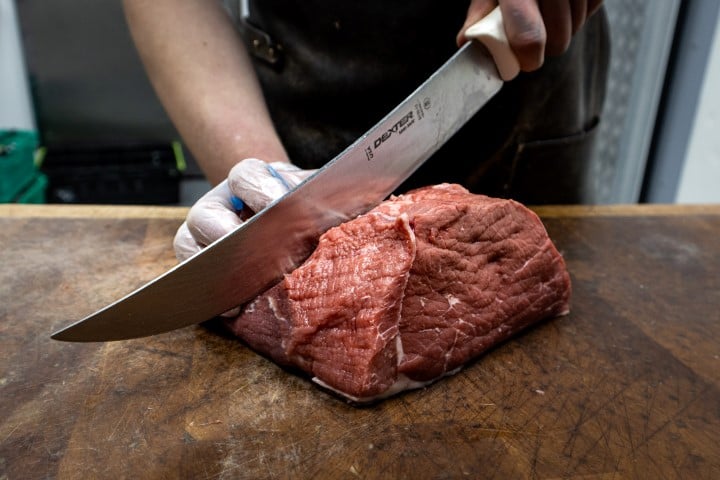Regarding beef, there’s nothing quite like a juicy, tender steak. Buying individual steaks is the most expensive way, buy bulk saves money.
However, purchasing steaks from the grocery store or butcher shop can quickly add up, especially if you have a large family or enjoy grilling out frequently.
That’s why many people are buying whole beef cuts to save money and get the most out of their meat purchases.
The site is all about preserving meat, often by curing it. I’ve been preserving meat for decades in different ways; one of them is breaking down the muscles or parts of animals to get more out of it and save money.
In this blog post, we’ll explore the cost benefits of buying whole beef cuts and provide some helpful tips for making the most of your purchase.
I like to do this for many whole cuts of meat, venison, and other red meat I procure.
Can You Save Money from Buying Whole Beef Cuts?
Yes, by purchasing larger cuts of meat, you can cut and freeze various pieces for beef steaks, cubed meat for braising, or cooking in liquid. You can also grind/mince the meat for many types of recipes and dishes.
Exploring Alternative Cuts of Beef for Cost Savings

When it comes to buying beef (I wrote a full article about preserving beef in another article) cuts, many people tend to gravitate towards popular cuts like ribeye or tenderloin.
While these cuts are undoubtedly delicious, they can also be quite expensive. If you’re looking to save money without compromising on taste and quality, exploring alternative cuts of beef is a smart approach.
Here are some alternative cuts to consider that can offer both cost savings and delicious flavor:
Chuck Roast
The chuck roast is a flavorful and budget-friendly cut from the cow’s shoulder area. It’s well-marbled and has a rich taste, making it ideal for slow cooking, braising, or pot roasts. The longer cooking time helps break down the connective tissues, resulting in tender and flavorful meat.
Flank Steak
Flank steak is a versatile cut that is known for its bold flavor. It’s an excellent choice for marinating and grilling or can be used in stir-fries and fajitas. While it requires proper cooking techniques to maintain tenderness, it is a lean and affordable option that can be quite flavorful when prepared correctly.
Skirt Steak
Similar to flank steak, skirt steak is a flavorful and economical cut. It has a distinct grain and is best cooked quickly over high heat. Skirt steak is commonly used in Mexican and Asian cuisine and is a popular choice for making fajitas and tacos.
Flat Iron Steak
Flat iron steak is a relatively new cut that has gained popularity due to its tenderness and affordability. It comes from the shoulder area and offers rich marbling and flavor. It is best cooked to medium-rare or medium to maintain its tenderness.
Top Sirloin
Top sirloin is a versatile, budget-friendly cut with a balance of tenderness and flavor. It is leaner than other cuts but can still be quite juicy when cooked properly. Top sirloin steaks are great for grilling or pan-searing, and they can be sliced and used in stir-fries or stews.
Brisket
A brisket is a large and flavorful cut from the cow’s chest area. While it requires long, slow cooking to become tender, it rewards with a melt-in-your-mouth texture and incredible taste. It’s commonly used for barbecue, smoking, or braising.
Shank
The shank is a less common cut from the cow’s lower leg. It is rich in connective tissue, making it ideal for slow-cooking methods like braising or stewing.
If you want to dissect the bone, you will need a butcher’s saw; I would often cook it in liquid, then freeze it into portions afterward for quick, easy, budget-friendly meals!
While cooking may require more time and effort, it offers a unique and flavorful eating experience.
Remember that these cuts may require different cooking techniques and times compared to traditional steaks, but you can create delicious and budget-friendly meals with a little experimentation.
Tips for Buying Bulk Beef or Other Meats
- Get a Vac Packing Device or well-made recycled Ziploc bags for freezing
- Manual or Electric Grinder for Meat is Incredible Useful
- Freeze a portion of cubed pieces for curry, stews etc.
I’ve seen many ‘throwaway’ meat grinders/mincers – I wrote something to highlight what to look for.
I wrote about decent mincers/grinders in this article here.
Cost Comparison Between Whole Beef Cuts
When you purchase individual steaks, you’re often paying a premium for the convenience of having them already cut and portioned.
However, when you buy a whole beef cut, such as a strip loin or ribeye, you can often get a significantly better price per pound.
For example, let’s say you’re planning a backyard barbecue and need ten ribeye steaks.
Each steak might cost you around $10 at the grocery store, totaling $100 for the entire package.
But if you were to purchase a whole ribeye, you might pay $8 per pound and get a 16-pound cut for a total of $128
You could save $28 or more by cutting your own steaks.
Plus, you’ll have the option to control the thickness of your steaks according to your preferences.

Easiest Cuts to Make Your Own Steaks Out Of
If you’re new to buying whole beef cuts, choosing easy cuts to work with and yield excellent results is essential.
Here are a few popular cuts that are relatively simple to turn into delicious steaks:
- Strip Loin (New York Strip): This cut is known for its tenderness and rich flavor. It’s often more affordable than a ribeye but still offers excellent marbling and juiciness.
- Ribeye: The ribeye is a favorite among steak lovers due to its incredible flavor and tenderness. It’s known for its generous marbling, which enhances the taste and juiciness.
- Sirloin: Sirloin is a versatile cut that offers good flavor and tenderness. It’s often more budget-friendly and can be used for grilling, roasting, or stir-frying.
Guide to Freezing the Cuts of Beef
When you buy a whole beef cut, you might end up with more meat than you can immediately consume.
Freezing the excess cuts is an excellent way to preserve them for future use. Here’s a simple guide to freezing your beef:
- Place the wrapped cuts in airtight freezer bags or containers, ensuring they are adequately sealed.
- Label each package with the cut type and freezing date to keep track of freshness.
- Store the packages in the freezer.
By properly freezing your cuts of beef, you can extend their shelf life and enjoy high-quality steaks whenever you desire.
If you want more ideas on saving money by cutting up bigger cuts, I wrote this post also.

Tom Mueller
For decades, immersed in studying, working, learning, and teaching the craft of meat curing, sharing the passion and showcasing the world of charcuterie and smoked meat. Read More
